3-way tower speaker with Beyma 12 inch woofer, SB Acoustics dome midrange and dome tweeter; elliptical crossover filter

- This is a low budget tower speaker concept using a large woofer, a rather small dome midrange and a dome tweeter. The concept is similar with the Yamaha NS1000/5000 and ATC SCM series.
- The transducers are a 12 inch woofer, a 2.5 inch dome midrange and a 0.8 inch dome tweeter. Well behaving, low priced transducers are chosen. Beyma 12BR70 woofer (110 euro/pc), SB Satori MD60N-6 midrange (130 euro/pc) and SBA SB21-SDC-C000-4 tweeter (32 euro/pc).
- Using a large woofer and a small midrange, the upper frequency response of the woofer and the low frequency response of the midrange are limited. With respect to these limitations, the crossover frequency of the woofer and the midrange has to chosen in the best way. Important to consider at first are the woofer medium frequency dispersion characteristics for a good directivity index match with the midrange. And secondly, at the chosen crossover frequency the excursion values of the midrange have to be within the maximum ratings at the maximum SPL level of the speaker.
- The speaker cabinet is a tower of 110 cm high, 38 cm wide and 42 cm deep. The netto internal volume is 110 L and the woofer speaker system is closed box.
Midrange and tweeter are placed horizontal asymmetric on the front baffle to improve the SPL on axis and the DI index responses of the transducers mounted in the cabinet. - The speaker sensitivity is 87 dB at 1m, 2.83 Vrms, full space, the low frequency response F3 = 42 Hz and for a woofer maximum excursion condition at 42 Hz the speaker maximum SPL is 105 dB @ 20 – 20000 kHz at 1m, free space.
Contents
- Specification Headlines
- Estimation Bill Of Material
- Speaker System
- Cabinet
- SPL and impedance curves of the transducers in the cabinet
- Horizontal polar diagrams of the transducers in the cabinet
- Off axis response, power and Directivity Index of the transducers in the cabinet
- Elliptical crossover filter
- Maximum excursion and maximum SPL with the elliptical filter
Specificaton Headlines
- System: 3-way, woofer closed box system, analog X-over
- Woofer: Beyma 12BR70
- Midrange: SB Satori MD60N-6
- Tweeter: SBA SB21SDC-C000-4
- Low frequency response: F3 = 42 Hz
- Sensitivity: 87 dB at 1m, 2.83 Vrms, full space
- SPL at maximum excursion, 42 – 20000 Hz: 105 dB, 1m, full space
- Crossover: elliptical 3rd order at 500 and 3000 Hz
- Impedance: mean value between 5 and 26 Ohm
- Cabinet dimensions: width x heigth x depth = 38 cm x 110 cm x 42 cm
Estimation Bill Of Material
- 2 x Woofer Beyma 12BR70: 220 euro
- 2 x Midrange SB Acoustics Satori MD60N-6: 260 euro
- 2 x Tweeter SB Acoustics SB21SDC-C000-4: 65 euro
- Components high quality crossover: 800 euro
- Components medium quality crossover: 500 euro
- Cabinet material: 100 euro
- Cabinet Accessoires: 100 euro
- Total with high quality crossover 1545 euro
- Total with medium quality crossover 1245 euro
Speaker system
Transducers
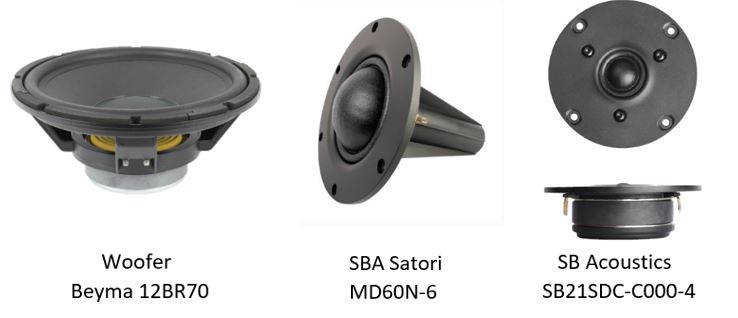
Beyma 12BR70, SBA Satori MD60N-6, SB21-SDC-C000-4
The Beyma 12BR70 is a 12 inch woofer that can be used in a closed box speaker system. The maximum excursion is 8 mm peak. The harmonic distortion is low, better than – 40 dB in the frequency operating range 40 – 500 Hz. See the distortion figures in this datasheet version.
To realize a closed box system with a Qtc = 0.70, a netto cabinet volume of 110 L is required.
The SB Acoustics Satori MD60N-6 2.5 inch dome midrange is a recent development. The harmonic distortion is low, better than – 45 dB in the frequency operating range 700 – 3700 Hz. This transducer has been measured by HifiCompass. This fabric dome midrange has a very good constant piston behaviour, see VCL EX17 for more details.
The SB Acoustics SB21SDC-C000-4 is a 0.8 inch fabric tweeter. The harmonic distortion of this transducer is low, better than -40 dB between 3500 and 20000 Hz. This transducer has been measured by HifiCompass.
This low size tweeter has a low directivity index up to high frequencies, which results in a flat power curve at high frequencies. This is the reason why this 0.8 inch driver has been chosen for this speaker.
Woofer – Small Signal Analysis
The 12 inch Beyma woofer is placed in a closed box of 110 L filled with sheep wool.
For this woofer: fs = 31 Hz; Vas = 142 L; Qts = 0.50 on infinite baffle.
Placed in the 110 L cabinet filled with wool: fc = 42.5 Hz and Qtc = 0.68.
The amount of filling can be determined by measuring the maximum impedance of the transducer atthe frequency fc. It has to be about 25 Ohm for Qtc to be 0.7.
Cabinet
Cabinet dimensions
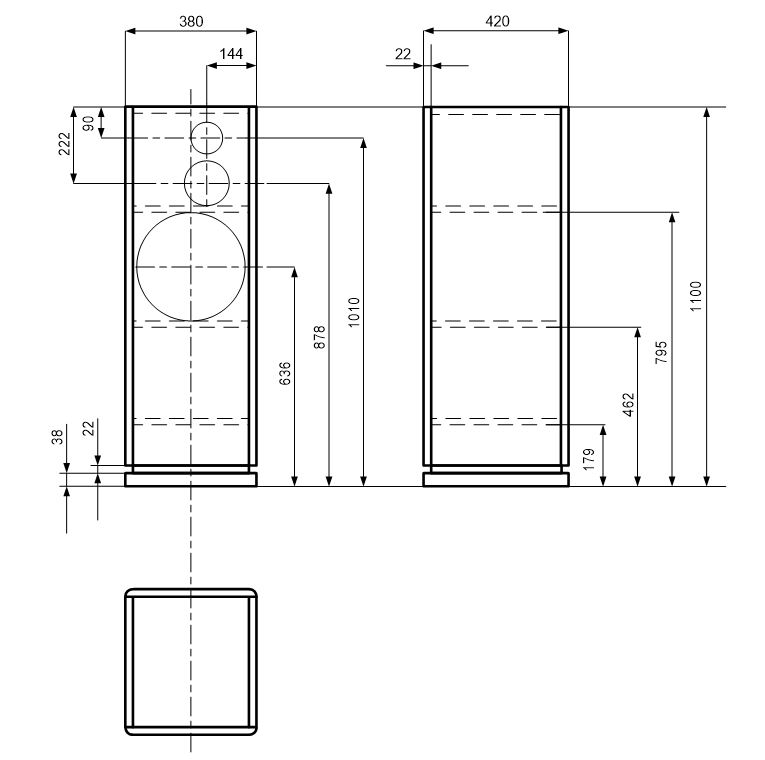
At the bottom inside the enclosure there is some place for the crossover filter.
All panels are 22 mm. Internal bracing is 18 mm.
3-D look in Leap
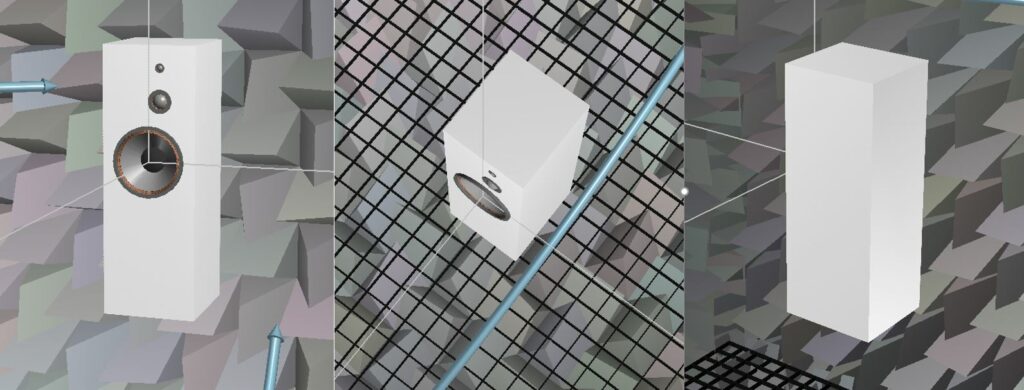
SPL and impedance curves of the transducers in the cabinet
These are the SPL and impedance curves of the transducers placed in the cabinet in free space at 1 meter, 2.83 Vrms . Also the SPL responses on infinite baffle are shown to see the impact of the cabinet shape on the response.
These simulated curves are used for a first crossover filter design.
SPL woofer in the cabinet on-axis in free space (blue curve) and on infinite baffle (pink curve)
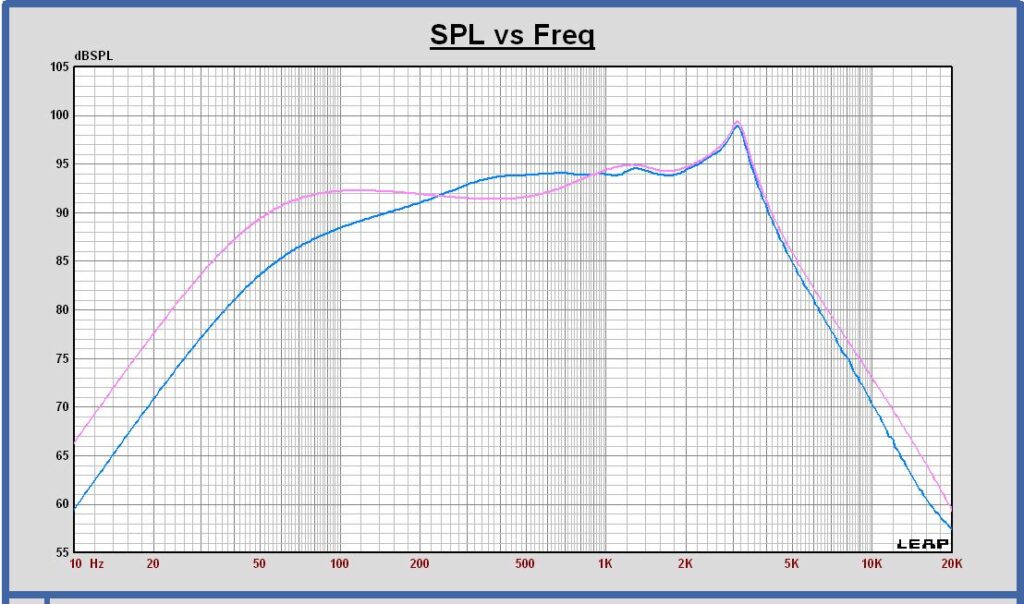
Impedance woofer Beyma 12BR70 in the cabinet
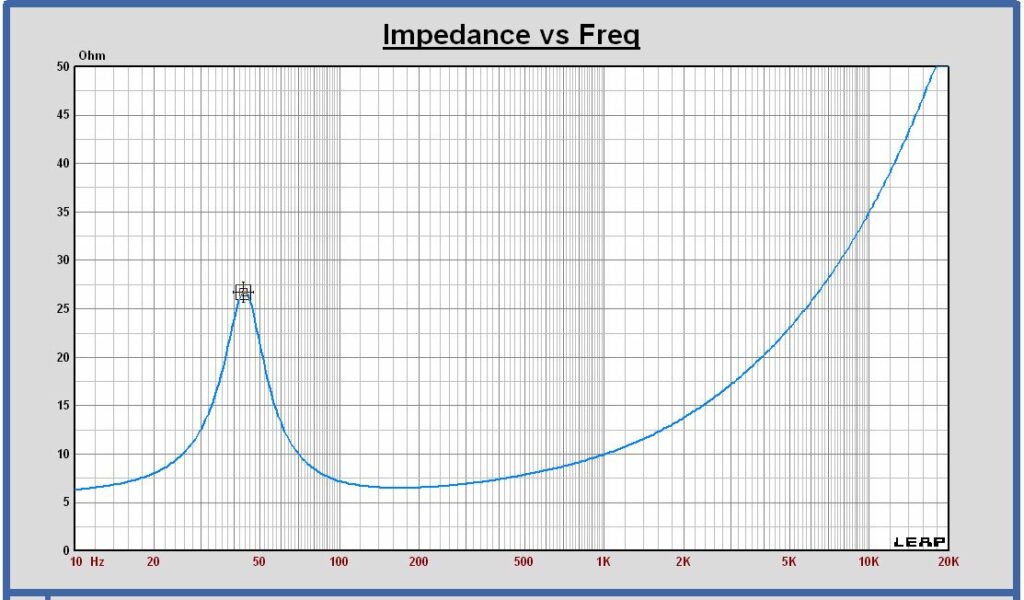
SPL midrange in the cabinet on-axis in free space (green curve) and on infinite baffle (pink curve)
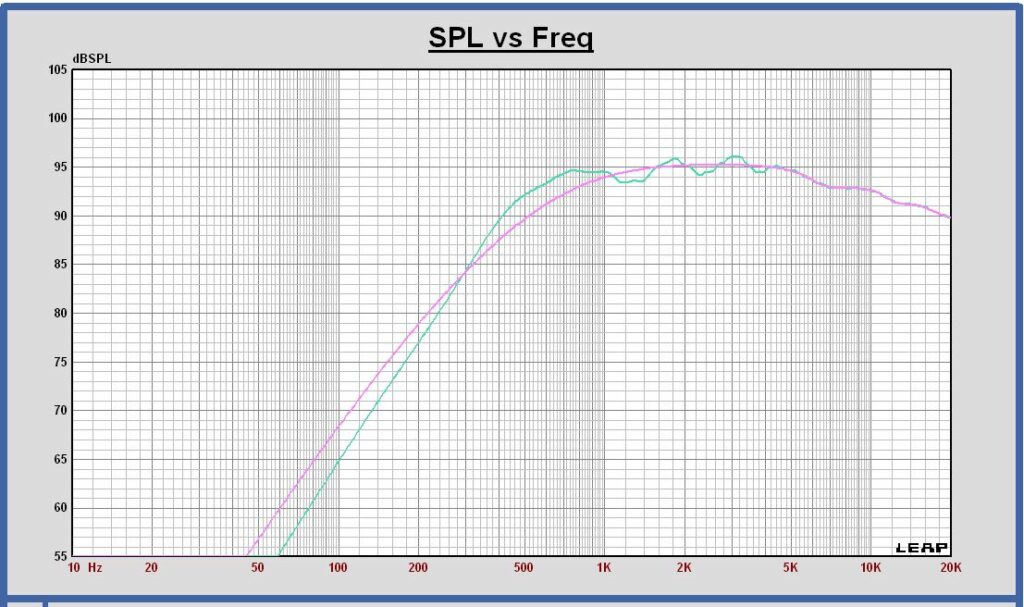
SPL SB21-SDC-C000-4 in the cabinet in free space (red curve) and on infinite baffle (pink curve)
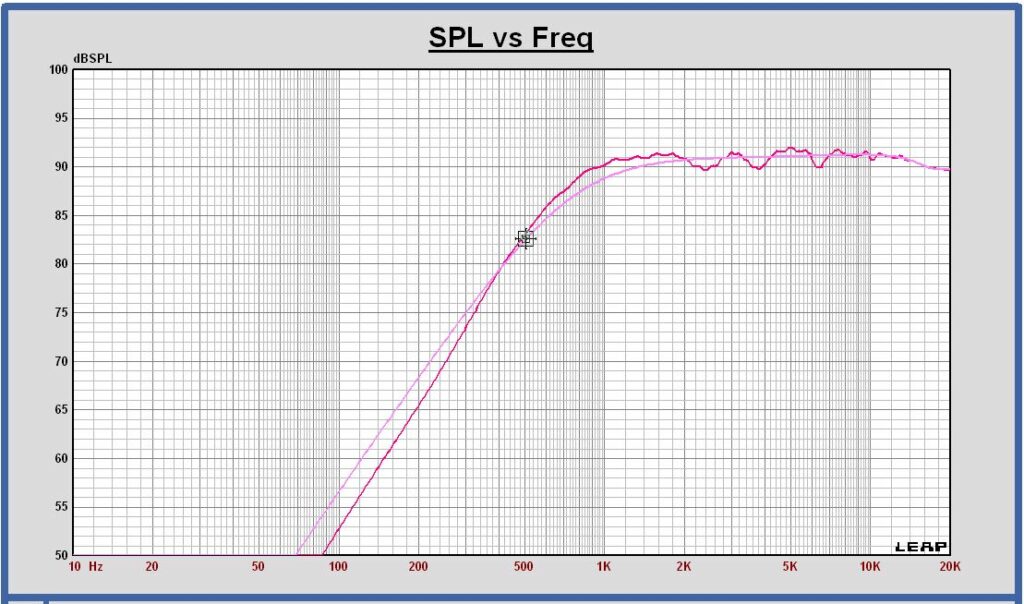
Horizontal polar diagrams
Horizontal polar diagram Beyma 12BR70 in cabinet free space at 80 – 160 – 320 – 640 – 1200 Hz
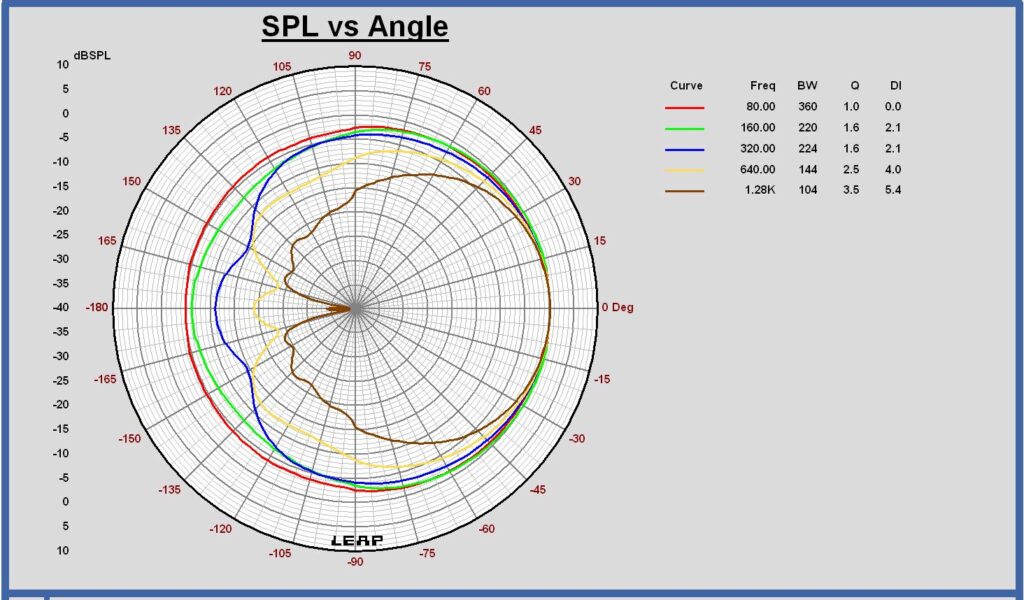
Horizontal polar diagram SB Satori MD60N-6 in cabinet free space at 80 – 160 – 320 – 640 – 1200 Hz
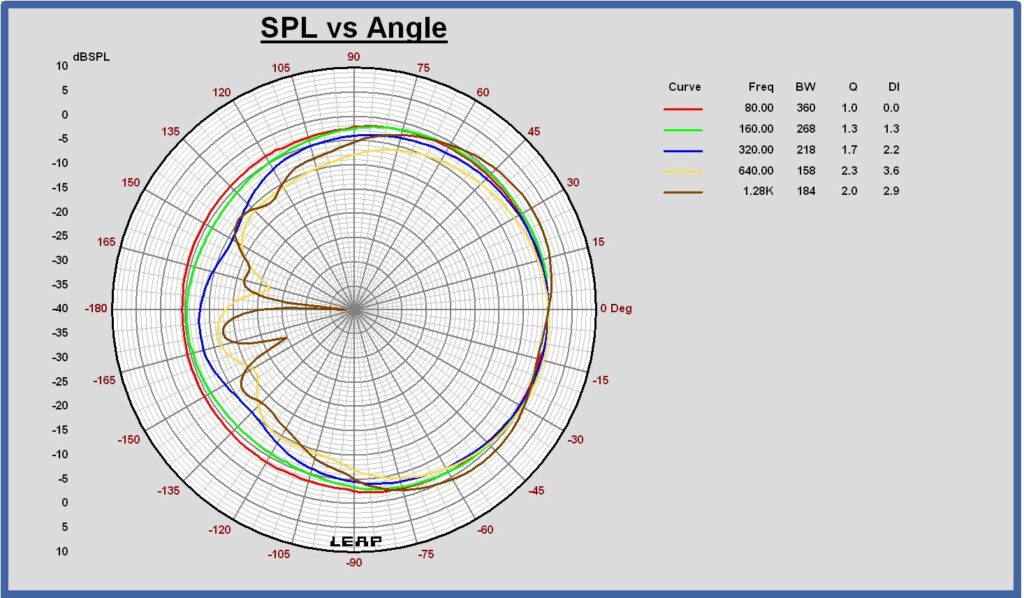
Comparing the horizontal polar curves of woofer and midrange. The 320 Hz and 640 Hz curves, that is the intended crossover frequency region of both transducers, are very close together. This behavior is mainly caused by the bafflestep, which increases the directivity of the transducers around 500 Hz for this front baffle width. Leap calculates a DI = 2.1 at 320 Hz and DI = 4.0 at 640Hz for the woofer and a DI = 2.2 at 320 Hz and DI = 3.6 at 640 Hz for the midrange.
It shows the importance of the front baffle width to get a directivity index increase around 500 Hz for both the woofer and the midrange.
Horizontal polar diagram SB Satori MD60N-6 in cabinet free space at 2.5 – 3.8 – 5.1 – 6.4 – 12 kHz
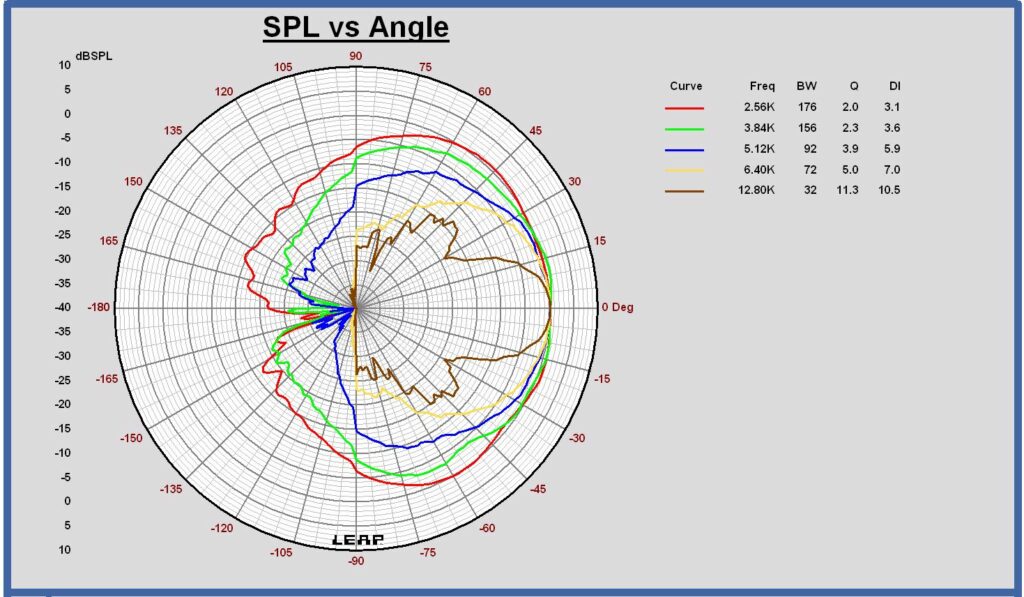
Horizontal polar diagram SBA SB21-SDC-C000-4 in cabinet free space at 2.5 – 3.8 – 5.1 – 6.4 – 12 kHz
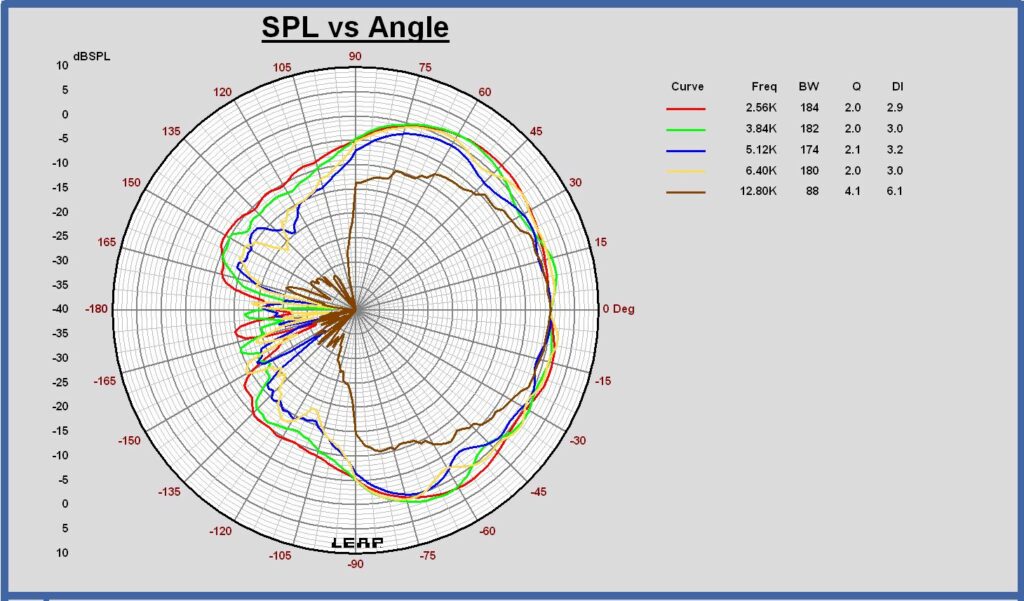
Comparing the horizontal polar curves of midrange and tweeter. The 2560 Hz and 3200 Hz curves, that is the intended crossover frequency region of both transducers, are close together. The midrange is a little more directional than the tweeter, but still acceptable to choose the crossover frequency of both transducers at 3 kHz. Leap calculates a DI = 3.1 at 2560 Hz and DI = 3.6 at 3200 Hz for the midrange and a DI = 2.9 at 2560 Hz and DI = 3.0 at 3400 Hz for the tweeter.
It shows that no tweeter waveguide is required to match the directivity index of both transducers for this speaker application.
Off axis response, Power and Directivity Index of the transducers in the cabinet
To calculate the power response and directivity index, the horizontal and vertical SPL off axis responses of the woofer, the midrange and the tweeter are simulated in steps of 15 degrees, the speaker placed in a full sphere at 3m distance. The power is calculated out of the mean value of these curves. The power is represented as the SPL of an omnidirectional source at 3m distance in a full sphere with a SPL value equal to the power.
Horizontal SPL on and off axis of the woofer in the cabinet at 0, 30 and 60 degrees
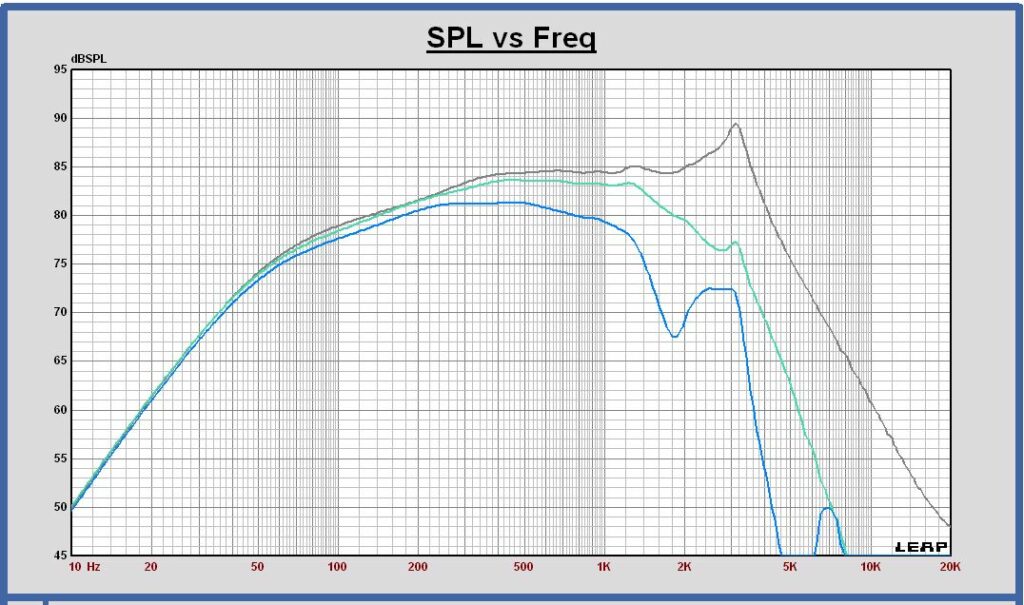
Horizontal SPL on and off axis of the midrange in the cabinet at 0, 30 and 60 degrees
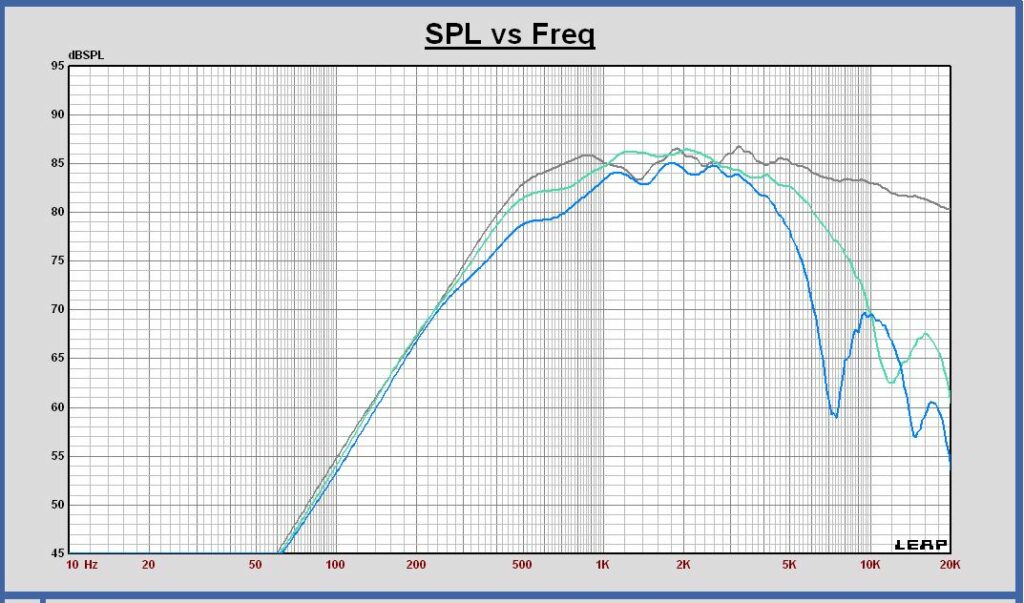
Horizontal SPL on and off axis of the tweeter in the cabinet at 0, 30 and 60 degrees
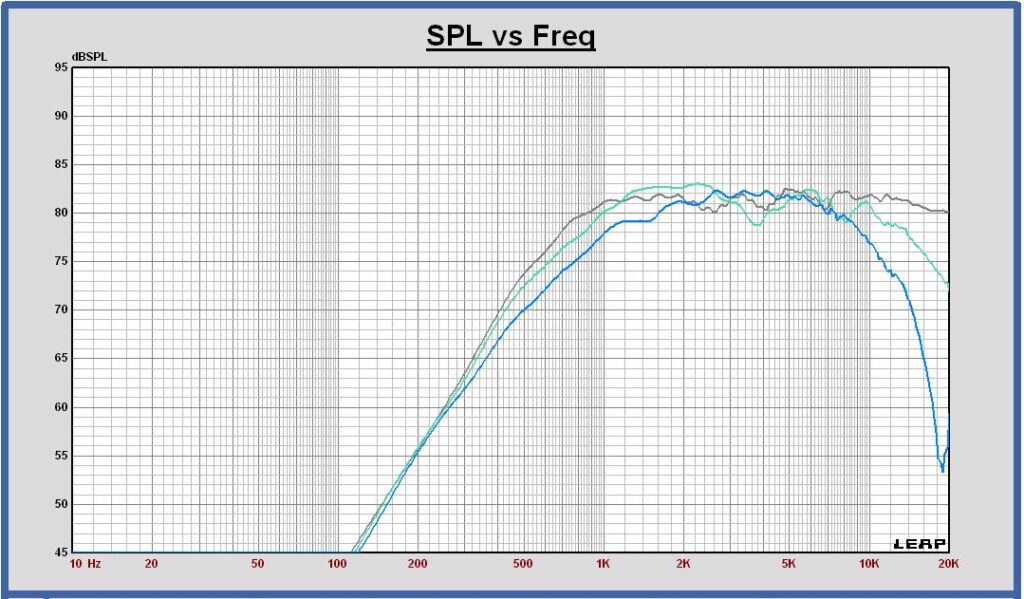
SPL on axis and Power of the woofer in the cabinet in a full sphere
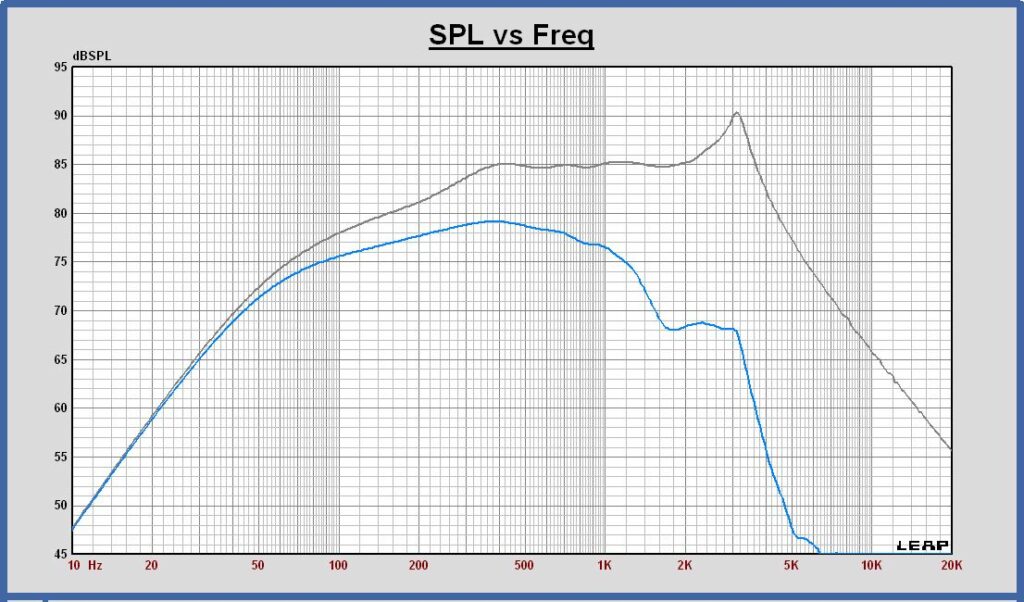
SPL on axis and Power of the midrange in the cabinet in a full sphere
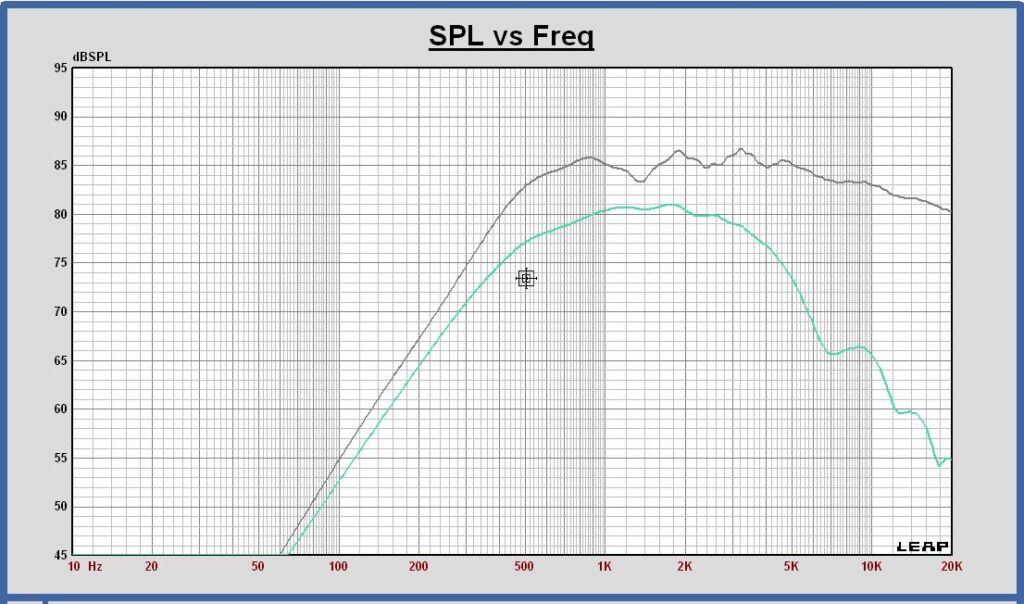
SPL on axis and Power of the tweeter in the cabinet in a full sphere
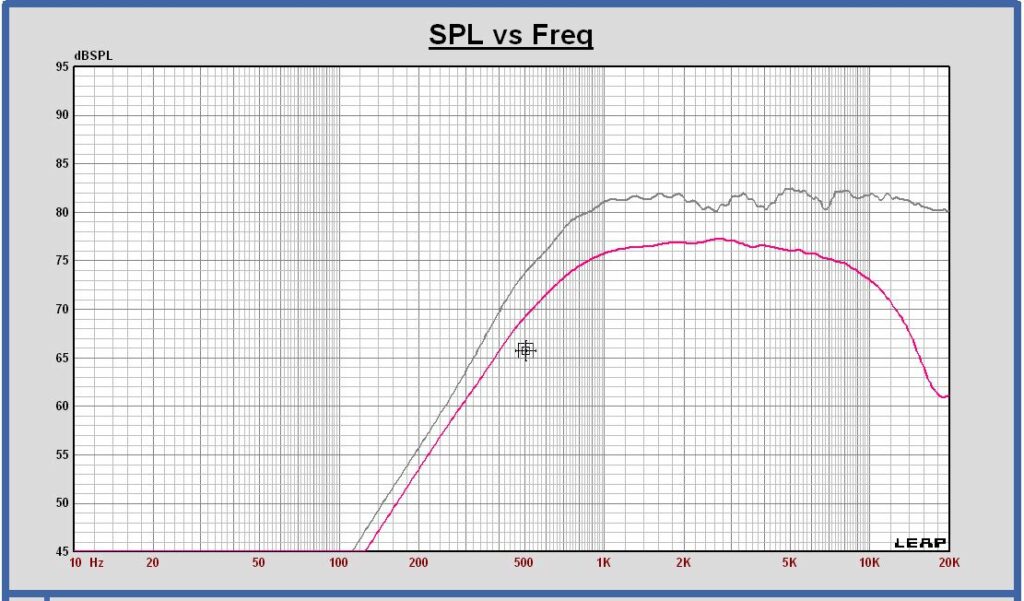
Directivity Index DI in a full sphere of the woofer, midrange and tweeter in the cabinet
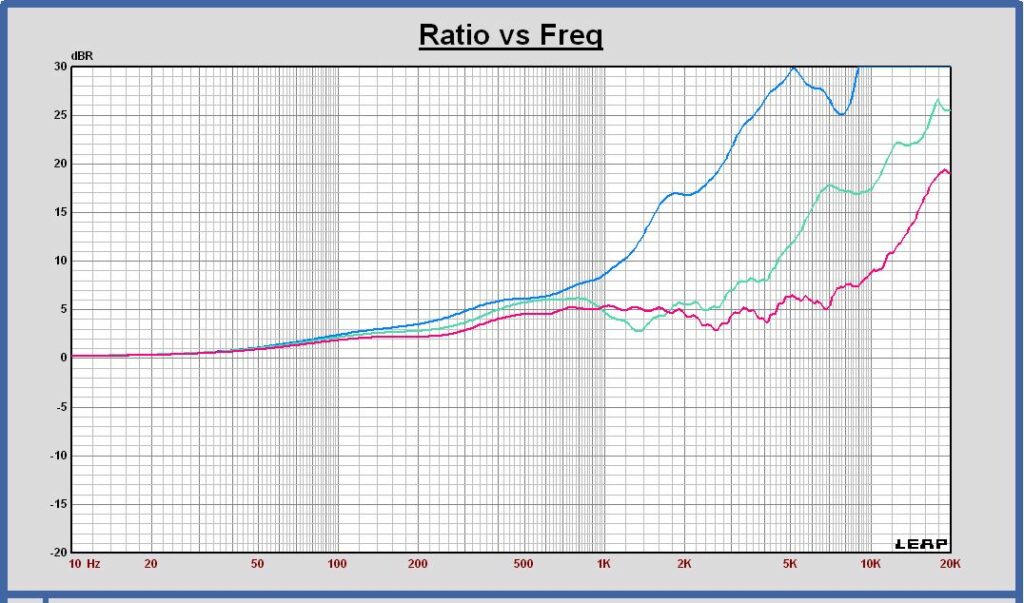
The Directivity Index plot shows that the woofer is a little more directional at 500 Hz than the midrange. And the midrange is a little more directional than the tweeter at 3000 Hz. Choosing the crossover frequencies at 500 and 3000 Hz will result in a constant DI equal to about 5.5 dB from 350 to 7000 Hz, meaning a constant power response from 350 to 7000 Hz.
Elliptical crossover filter
Targets Crossover Filter Elliptical 3rd order at 500 and 3000 Hz
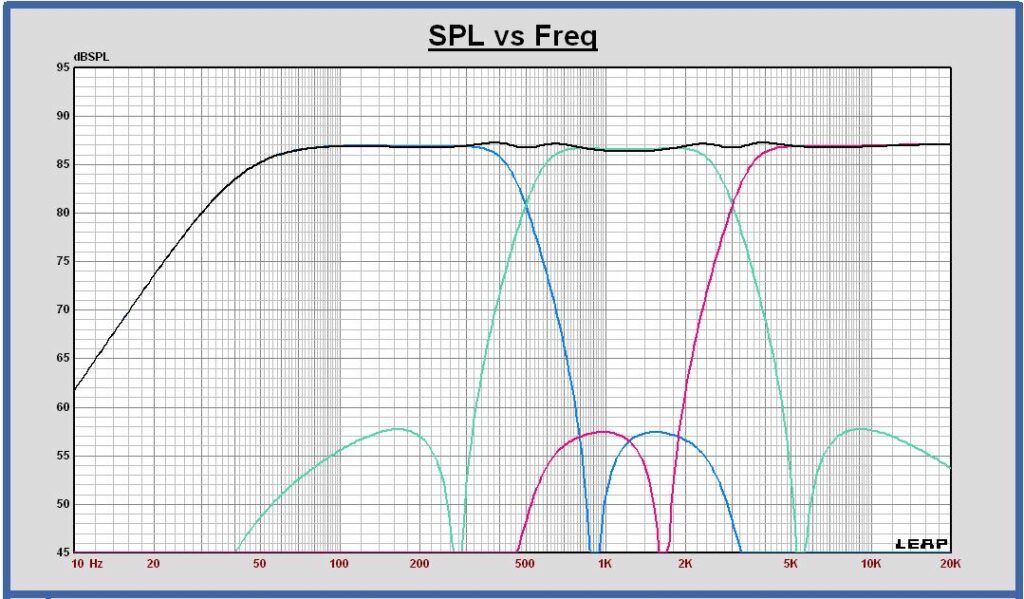
Crossover filter schematic configuration
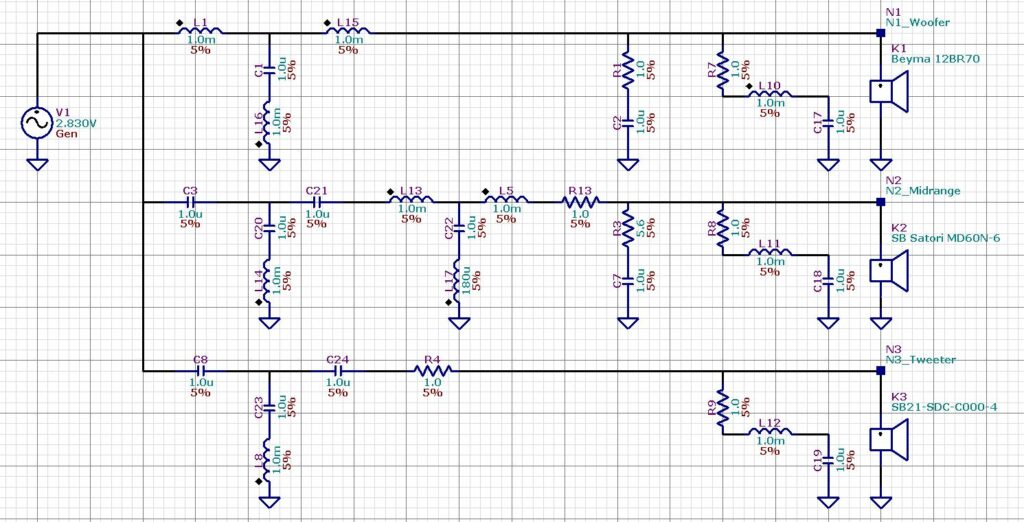
Impedance with crossover flter
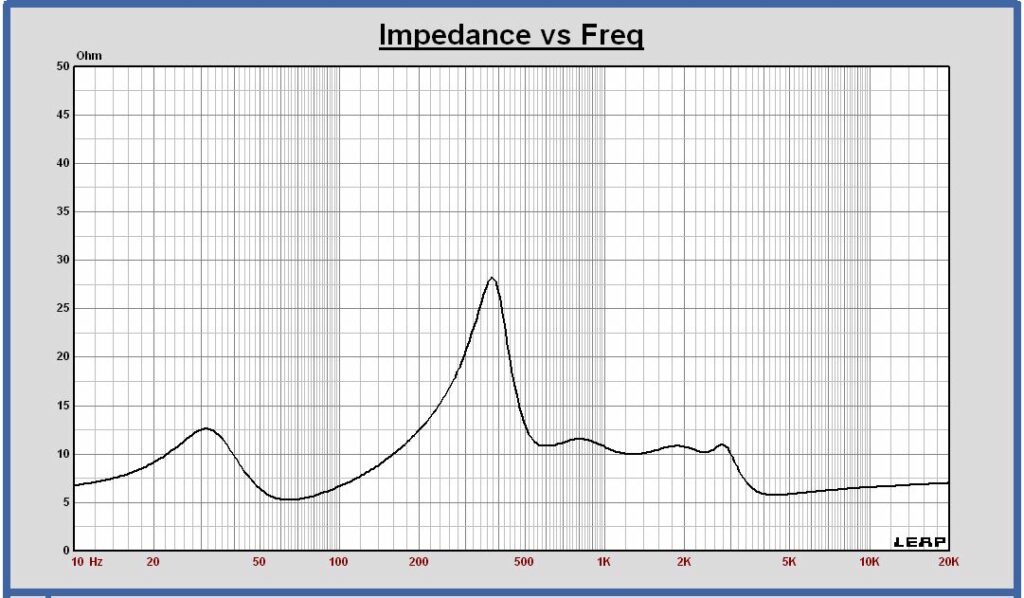
SPL on axis of the filtered drivers and the sum at 1m, 2.83 Vrms
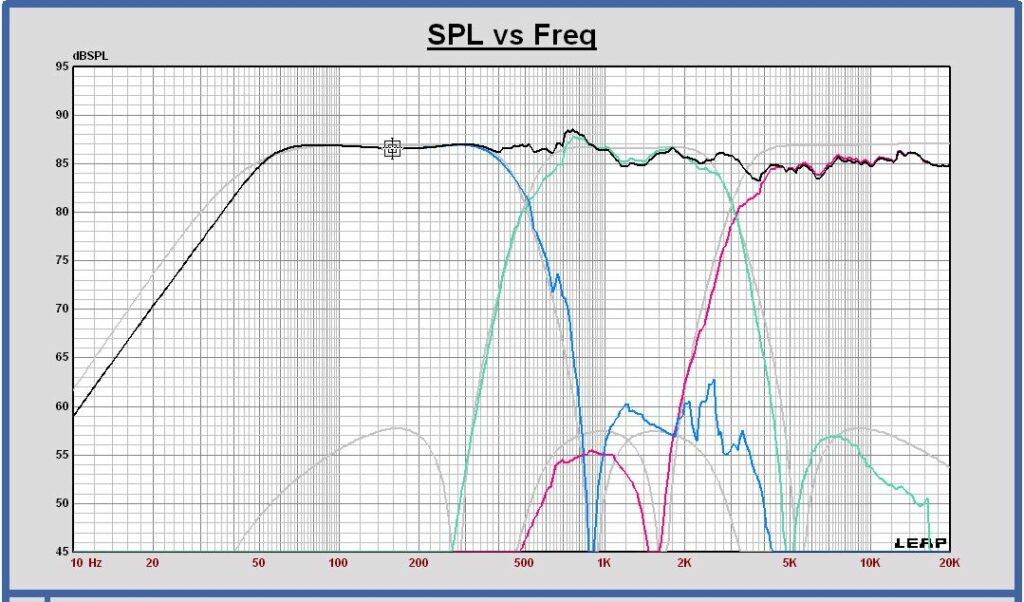
To reduce the high frequency power off axis at 30 degrees and especially at 60 degrees, a smooth SPL fall off up to high frequencies of 2 dB is integrated for the on axis SPL response.
SPL horizontal off axis of the sum at 0 , 30 and 60 degrees at 3m, 2.83 Vrms
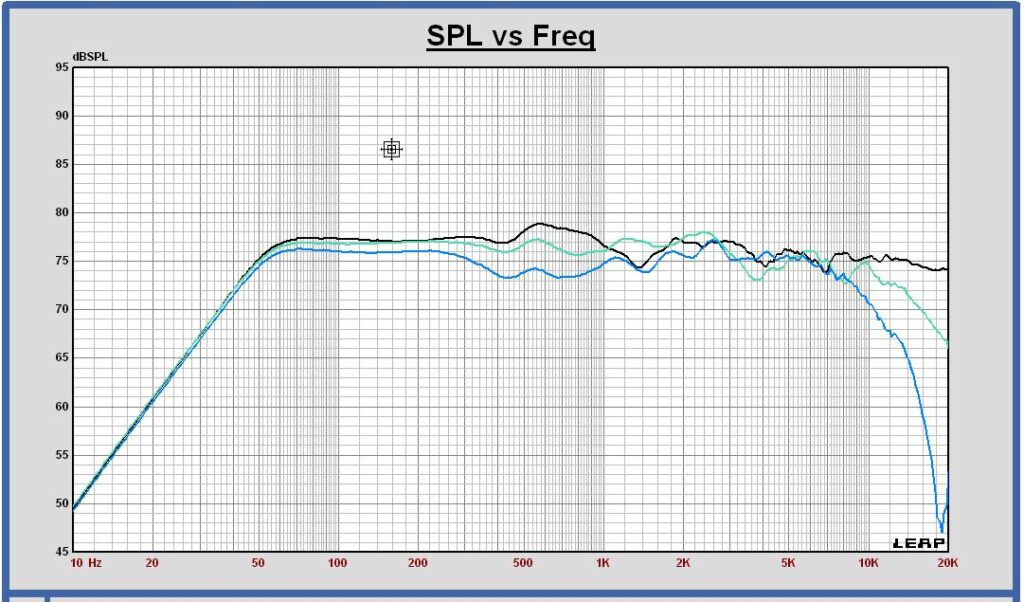
SPL horizontal off axis of the filtered drivers and the sum at 30 degrees at 3m, 2.83 Vrms
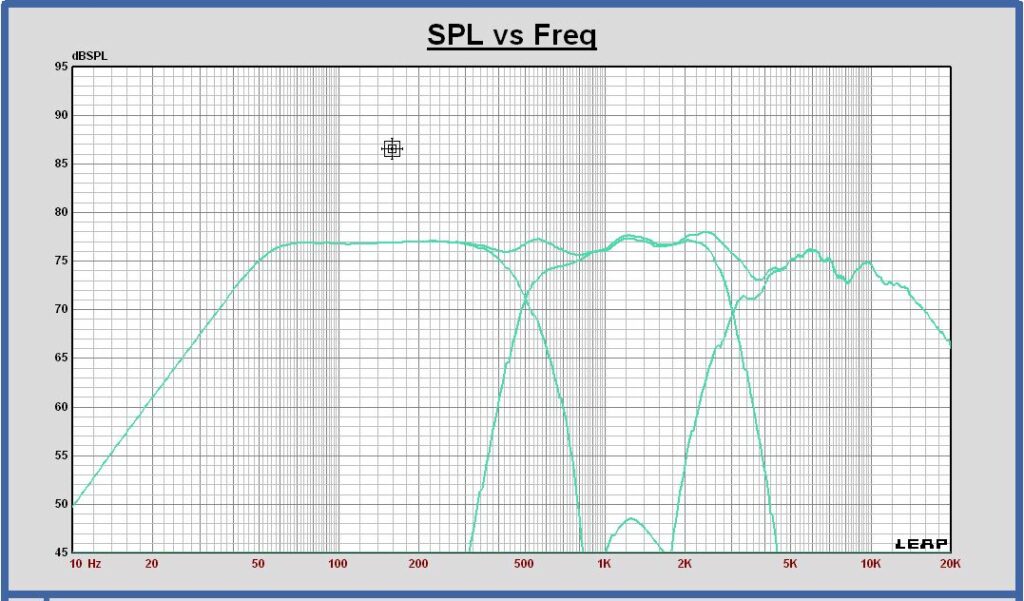
SPL horizontal off axis of the filtered drivers and the sum at 60 degrees at 3m, 2.83 Vrms
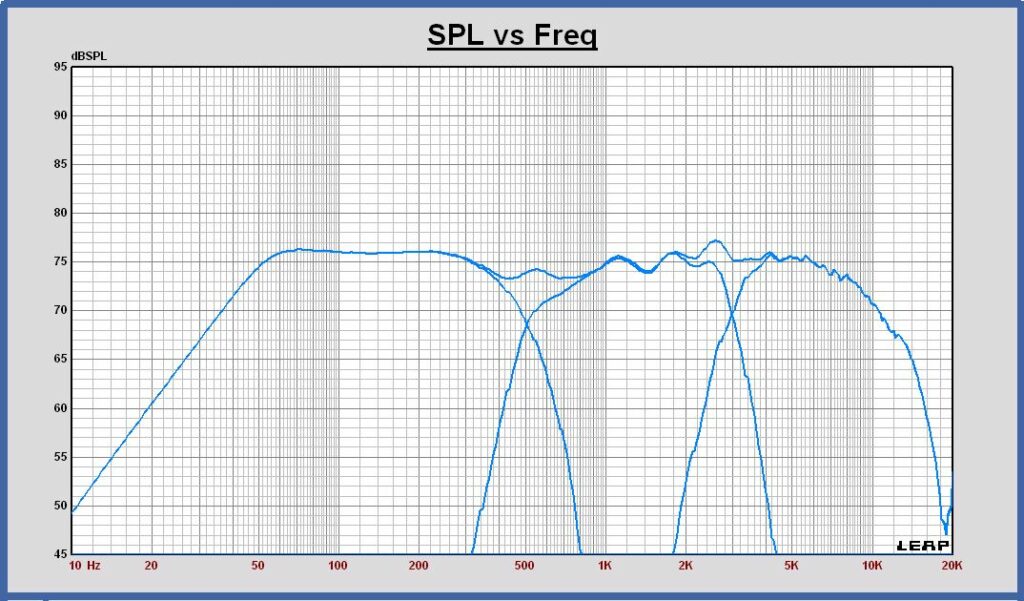
In the off axis responses there can be observed that the transducers have a good directivity match in their frequency overlap zones.
Power response of the filtered drivers and the sum in free space at 3m, 2.83 Vrms
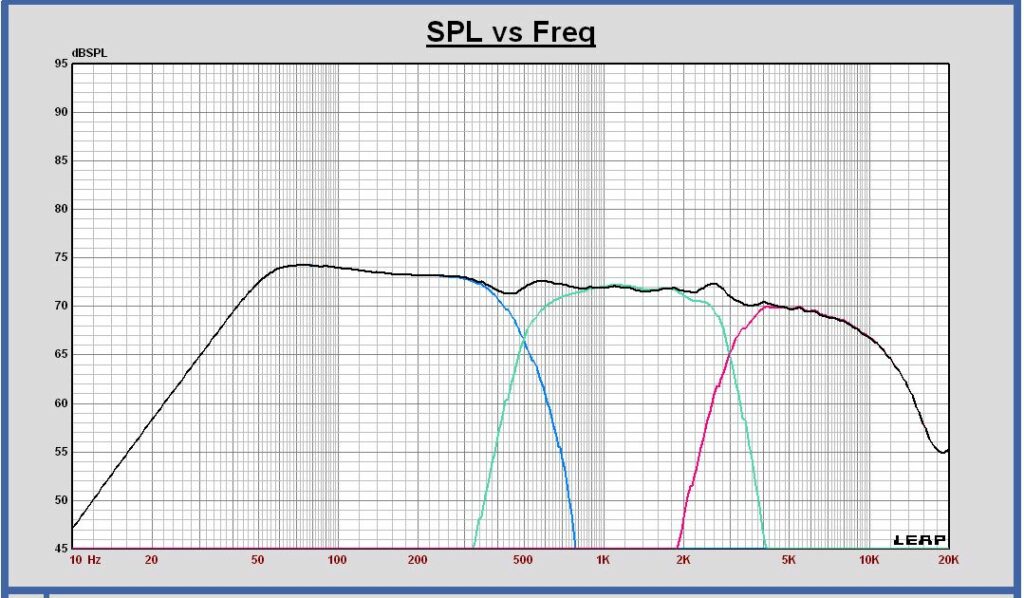
The mutual distance between the drivers in the vertical direction is not included in this calculation. With this distance included, an extra power dip at the crossover frequencies will appear with a DI peak as a consequence.
Directivity Index in free space of the filtered drivers and the sum

Maximum excursion and maximum SPL with the elliptical filter
Maximum Excursion
With the designed elliptical 3rd order filter, the woofer has a maximum excursion of 8 mm peak at 42 Hz for a voltage of 21.7 Vrms at the input of the filter.
The excursion of the midrange and the tweeter have been calculated also at 21.7 Vrms.
Excursion at 21.7 Vrms of woofer (blue), midrange (green) and tweeter (red)
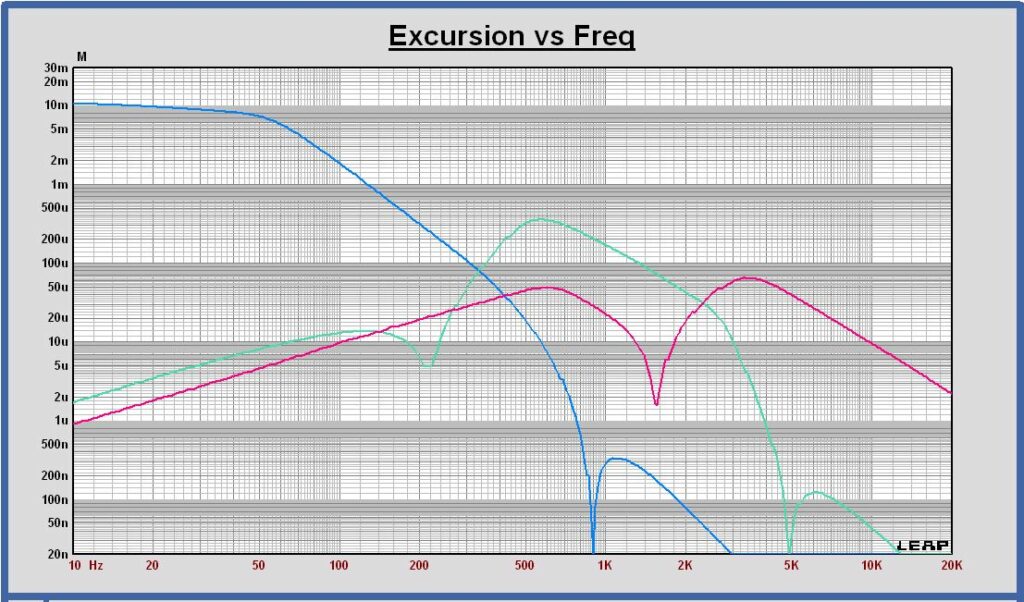
The midrange excursion is maximum at 567 Hz and equal to 0.353 mm peak. The maximum specified linear excursion of the SB Satori MD60N-6 is 0.5 mm peak and is reached at 30.7 Vrms or about 100 Wrms in 8 Ohm at the input of the filter.
The tweeter excursion is maximum at 3337 Hz and equal to 0.065 mm peak. The maximum specified linear excursion of the SBA SB21-SDC-C000-4 is 0.5 mm peak.
Maximum SPL
The maximum SPL for the operating frequency range 42 – 20000 Hz at maximum excursion of the woofer is 104 dB at 1m, 21.7 Vrms at the input of the crossover filter.
